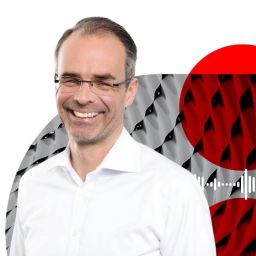Leaders make difficult decisions – double-down or step back, invest or cut. But success is not only about the decision, it’s also about the process. So… How do you make tough calls a win-win?
Co-founder and COO, Arjen Schouten ((IESE MBA, who helped Rituals, the home and body cosmetics retailer, grow from zero to over 10,000 employees and $1 billion in turnover) and Professor Sebastian Reiche, Professor of Managing People in Organizations at IESE Business School (one of the world’s best business schools) – ranked No.1 in the world for six years running by the Financial Times explore how to make tough decisions as a leader.
Is letting people go the hardest thing to do in business? And is disagreement healthy?
This is Real leadership podcast: Every episode, a business leader shares human stories and hard truths from their career. And an expert turns those stories into lessons we can all learn.
In this episode, Arjen and Sebastian explore:
- How to manage leadership clashes
- What is the most demanding stage of business growth?
- How to keep a start-up culture as the company grows
- How to adapt to different cultures
Listen to this podcast:
Listen & subscribe on:
Spotify Apple podcasts Amazon podcasts
Fore more content like this visit the Real Leadership website.
Podcast transcription:
Adam:
Hello and welcome to This is Real Leadership. Where, every episode, a brilliant guest shares human stories and hard truths from their career as a business leader. And an expert turns those words into lessons we can all learn.
I’m Adam Burns. I’ve been talking and writing about business leadership for over 25 years. And I still have a lot to learn. Which is why, in this podcast, I’m joined by that expert – a distinguished professor from IESE, one of the world’s best business schools – ranked number 1 in the world for six years running by the Financial Times.
They’ll also be talking with our guest. And then, just with me. Offering their expert analysis of the conversation, as I ask: what are the real leadership lessons here? The things we can all use to make a positive impact on ourselves, the people around us, our organizations, and society as a whole.
No buzzwords. Real people, real talk.
Welcome Professor Sebastian Reiche…
Sebastian:
Hi Adam. It’s a pleasure to be here.
Adam:
Now, this episode is about making tough decisions. You’re IESE’s Professor of Managing People in Organizations. And people management, of course, is an area where tough decisions are often made. What is the biggest lesson you’ve learned?
Sebastian:
From my own experience interacting with many executives, I think there’s often a temptation to delay or postpone or avoid tough decisions, because we prefer to please, rather than deliver bad news. And, of course, this temptation is driven by our own interest. To give you an example, when I ask managers when they would communicate a decision to fire or let go of someone, many managers will say, on a Friday afternoon. Because, under their rationale, it’s the thing you get off your plate before the weekend, and the person you fire is less likely to have interactions with other people who are around on Friday afternoon. But, obviously, from the perspective of the person who is being fired, if you communicate this on a Friday afternoon, there’s not much social support you can provide. It’s difficult to have a follow-up conversation with the person about the next steps. And a lot of things can happen over a two-day weekend, without having emotional support for someone who’s been with the company for a long time. So, to make tough decisions, we need to walk in the shoes of the ones who are affected, and see it from their perspective. That doesn’t mean you shouldn’t go through with a tough decision. It just means that you need to think very carefully about how you deliver it, and in what context.
Adam:
Tough decisions. So, who is our guest? Arjen Schouten co-founded Rituals, the home and body cosmetics retailer, in 2000. Over 20 years, in his role as Chief Operating Officer, he helped Rituals grow from zero to over 10,000 employees, 1000 stores and $1 billion in turnover, selling up in 2020 and, amongst other projects, starting the ShareAndWonder Foundation with his wife Eliane, to support charity projects in East Africa.
We asked Arjen to revisit some of the hardest decisions in his career. And we start with the hardest…
—
Arjen Schouten:
Well, there was one moment in our Rituals life where there was, kind of, a leadership clash between the co-founders; and there were five of us. There were just too many captains on the boat. And we also had to decide how to move forward after the first 10 years, to see how we were going to manage the company in the next 10 years. At that moment in time, I had to look at myself and decide how to move forward. I decided to stay loyal to the business, and also to the idea of having only one captain on the boat. And in the end, you know, we had to buy out one of the co-founders, with all the frustrations and negative impact, and also financial complications, that this brings. But, I believed it was better for the long term. And we also owed it to our teams to be very clear about how we would lead the company.
Sebastian:
Hmm. I can see this is delicate because, I guess, as a co-founder, it’s not only a professional relationship, but there’s probably also an emotional connection. Obviously, you’ve built the company from scratch. How did you confront the co-founder that you bought out, then, afterwards?
Arjen Schouten:
Well, it’s like a marriage, right? If you don’t get along with each other, there comes a moment when you have to break up. And that hurts both of the people involved. It’s the same here. And, before you come to such a clash, probably, over time, things have happened already. And, probably, you haven’t spoken about it in the right way, or didn’t dare touch upon these delicate issues. So, when it then comes out, you just have to deal with it and come up with a solution. But, in the end, it definitely has an impact, not only on your professional relationship, but also, afterwards, on your relationship as friends.
Adam:
Are you back on the Christmas card list?
Arjen Schouten:
I am. Well, we still see each other, so, you know, we’re still good.
Sebastian:
That’s interesting. You mentioned that you owed it to the team. So, you’re juggling the relationship with that co-founder, and with everyone else in the organization.
Arjen Schouten:
Exactly. Absolutely. In the end, when you are in business, and when you are a leader, the teams that you’re working with ask for clarity and direction. And anything that gets in the way of this makes it harder for them to operate. Especially when they are sensing that there are different signals from the leadership team.
Sebastian:
So, you’ve built Rituals as a company, over 20 years, from scratch, right? And you mentioned people are longing to understand direction. I’m sure you must have changed directions as you build the company to over 10,000 people, right? But if you look back across those different stages of the organization, which one was the most demanding for you and your leadership team?
Arjen Schouten:
The first years of setting up a company are the toughest ones, because you need to come up with your proposition, and you need to find a proof of concept in the market. So, there are different elements in the business that have an impact on you, and on your team, and that lead to insecurity. And you have to deal with that insecurity. That is a very demanding period, because you’re busy 24-7, in order to get it right. And you’re, more or less, in survival mode. You feel it financially, and personally as well. It demands a lot of energy and, as I say, it requires the three Ds: the drive, the discipline and the determination to move forward. But the good thing about it is that you are acting, all the time, on the front line. Whether it’s being hands-on on innovation, or being hands-on on the go-to market and on the front line. You’re really involved in every single detail of the business. And it’s especially in that phase, in the early stage of the company, that you create your founders’ mentality. Actually, the mentality or the DNA of the company is created in those years, and you create the spirit of the company.
Sebastian:
But then you grow, and as you grow, people are less connected. They’re spread out, they’re dispersed. So, in a way, you also lose some of that proximity that you initially built up. How do you still diffuse this mindset that you’ve built from the start?
Arjen Schouten:
That’s a good point. So, the middle management and the role of the middle management becomes crucial. Because, in the end, they are the ones that lead the workforce. So, how do you inspire the middle management, and the leadership teams in the middle? If you don’t do that right, they get stuck in the middle. But you really need to empower them. You need to work with them, and you need to visit the front line together with them, and see how you act. See how you talk to your teams and how you interact, and what you learn and what you give, and then inspire them to work in a similar way. But, the other thing that we did, at least, was, about seven or eight years ago, so we were 14-15 years in the business, we also created some structure, to make sure that we taught our middle management, and the new people in the company, what we meant by that founders’ mentality. So, we created a root camp. The Rituals root camp, which is a root camp that every new member gets. It’s onboarding for at least three days, up to one week. And they learn everything about the history of the company. They learn about the successes, but also about the failures of the company. And these three days are led by the leadership team. So, every month, myself and my partners needed to show up for at least one day in that program to work with those teams and share our experiences with them. And sometimes, as a leadership team, we had discussions, like, “Shouldn’t these people be at work, or shouldn’t they be in stores? Shouldn’t they be on the phone or in their day-to-day role?” It’s very tempting to, again, start saving money and time on that. But, we were always able to convince each other, “No, we have to live up to this. And it’s an essential piece of our business, especially when we’re growing so fast, to keep that spirit of the company.”
Adam:
You talk about being at the front line, being amongst it, leading by example. A lot of the language you’re using is that, kind of, very dynamic language of leadership. So, what happens when something goes wrong? How do you lead by example there?
Arjen Schouten:
When something goes wrong, well, don’t hide it. Be open about it. And also, you know, explain to people that you saw it wrong, or that you made a mistake, or whatever. It’s okay to make a mistake. And it’s also okay for the people around you to make a mistake.
—
Adam:
So, breaking up is hard to do, in business as in life. But if splitting with a co-founder was Arjen’s toughest decision, his toughest years forged the most important lesson. While his company was growing rapidly from zero to over 10,000 employees, close and consistent senior leadership attention and nurturing built a consistently successful culture. And it’s that culture that helped Rituals to over $1 billion in turnover.
The next part of our conversation, then, is about real talk. Specifically, Sebastian wanted to know how Arjen’s own, direct leadership style worked across cultures…
—
Sebastian:
How you give feedback, how you explain clearly to others, and how you lead by example probably depends a bit on the cultural context. So, if you have teams, or are leading teams in different contexts, have you adapted your style there? Did you have to…being crystal clear, being direct may work in some contexts…
Arjen Schouten:
Yeah…
Sebastian:
Better than others…
Arjen Schouten:
Yeah…
Sebastian:
Or…
Arjen Schouten:
No, no, I understand. I understand your point. Yes. And I’ve made mistakes. For example, I sent a Dutch leader to the States where the mentality is very, very different. Same goes for England. And what I’ve learned is that you’re better to let the local teams be managed by a local leader, because they talk the talk better than we do. We, as Dutch people, for example, we are very direct, and we like that.
Sebastian:
That’s where the question came from.
Arjen Schouten:
Yeah, yeah, and we like that. And the senior managers in most of the markets, my country managers, for example, and local leaders were reporting to me, if I can believe them, that they were pretty happy with the way I was leading them because I was very clear. I’m not saying that things always went smoothly, because they also had to get used to that. And I had to learn how to lead them, and especially I had to learn how they were leading their teams. I, for example, could have never led a French team or a Spanish team the way they did.
Adam:
But how do you also make sure, if you’ve got somebody who’s brilliant, but they’re Dutch and they’re direct, and you need somebody in the UK, how are you getting that balance?
Arjen Schouten:
Well, if that person is so brilliant that they are willing to learn and adapt to a local market, you could consider sending someone like that over to such a market. But, to learn a culture, and to speak the language in the right way, deal with the people in the right way, that really requires years of investment. And I am not sure that those brilliant people are always ready to invest that amount of time in learning a culture and learning how to deal with people. And I’m 100% sure that in every single market you’ll find brilliant people. And that it’s just a matter of training them, educating them, getting them on board, and being patient until you find them. And sometimes it takes time. Sometimes I had gaps in my operations for a couple of years in a market, because I couldn’t find the right leader. And I tried somebody else that was just not right. And I said, well, we’re going to train, we’re going to…but it didn’t work out. So, finding the right people, at every single level of any business, is the most important thing to work on and should always be at the top of the list for any leader.
—
Adam:
So, real leaders must accept that their style may not be right for every person, every team, or every market. As Sebastian said, “being direct doesn’t work everywhere”. Which means the most important thing you can do is find the right people.
But sometimes, tough decisions have to be made by even the most sensitive leaders. And handling disagreement is a part of life. Before I speak with Sebastian about his lessons from Arjen, here are the two of them discussing dispute, the golden rule of mistakes, and saying goodbye.
—
Sebastian:
Disagreement is potentially very good, right? Because it forces us to rethink, stress test, make better decisions. But it can also undermine collaboration and decision-making. How did you ensure that, whenever you had conflict and disagreement, you stayed productive, you actually made better decisions, rather than it becoming a problem?
Arjen Schouten:
Well, Sebastian, it’s good to have conflicts as long as they are dealt with in a positive spirit, and in a human way. And as long as they are supportive to the business. So, I think that you need to let your teams come up with their own solutions, and give them the freedom to be brave and implement their ideas, and let them make their own mistakes, as you have made your own mistakes. And that is the hardest thing, because you’re very tempted to say “No, that doesn’t work”. But, don’t be afraid. Let them be vulnerable, and don’t punish them too early for the mistakes they might make. There’s only one thing, one golden rule, which is to not make the same mistake over and over again. Then, you might have an issue. But also, that is easy to deal with because other people around you, in the teams, they see that happening as well. They will ask you to solve it and to get into a potential conflict, and move towards separation. But, the only thing that you need to do is be very clear about why you are separating.
Sebastian:
I was going to ask about separation, because sometimes we can improve, but sometimes it doesn’t work that way. So, if you have to separate, if you have to let someone go, how do you do this?
Arjen Schouten:
The trick is that you have to be very clear from the beginning. From the beginning, when you are hiring someone, be clear about what you expect from the person. And where you want to go with the company, what your vision is for the future, how you want to do it. And be very clear about it from the beginning. I always had a few golden rules when I was hiring people. You know, the dos and don’ts. Because that is the way I wanted to manage the business, right? So, they could say no from the beginning. Listen, this is not my way, so I’m not going to work here. And you have to be very open. As we say, you have to put the fish on the table before it starts to rot. And hey, don’t get me wrong, it’s never easy to separate. It’s never easy. If it were easy, then you would be a bad leader, I think. Separation is the most difficult thing in business. And it should it remain difficult. So, these were my learnings, you know? Be clear from the beginning, and keep talking to each other.
Adam:
And Arjen, you’re cycling, you’re training for Ironman type competitions, you’re clearly fit, you’re clearly motivated, all these sorts of things. Why then, after 20 years, in 2020, did you take the tough decision to leave?
Arjen Schouten:
Yeah, that’s a good question. And I think, if you were asking… Friends have asked me, Arjen, what were the toughest decisions, and maybe also the best decisions, in your life? I say, well, in my professional life, probably the best decision was that I started with Rituals. The toughest, and maybe also one of the best ones, was that I stepped out of Rituals. Because we had been very successful, and when you are very successful you are on a high. And why step out of something like that? But, my personal philosophy is that there is more to life that I’d like to discover. And I wanted to create some room to discover other aspects of life. I learned a lot over time. I enjoyed a lot, but I wanted to get back to society in a different way. I wanted to be a bit more involved in the coaching and education of young entrepreneurs, which I do now. And there’s a couple more things on the list, but I’m taking it step by step.
Adam:
Arjen, thank you very much indeed.
Arjen Schouten:
Gentlemen, it was my pleasure. Thank you.
—
Adam:
So, Sebastian, it is time for your analysis. We promised real people, real talk and real business lessons you can use. What did you learn? What do you take away from Arjen?
Sebastian:
I thought we had a fascinating conversation. And, as I was thinking about the key insights, I had to think of three takeaways. If you like, we can think about the three Cs here. Okay? So, the first one is collapsing social distance. Arjen talked about his obsession with the front line. About being there, being with the local teams, empowering people, having others make their own mistakes, rather than following your own temptation to step in. And collapsing the social distance, or being closer to your team, I think, is a very important part of creating a space that’s safe, where people can be vulnerable, where you can build and earn trust. In my own research, for example, I’ve found that leaders who become more equal to their team defer downwards rather than upwards. They actually defer downwards by reducing social distance, by transferring influence to the team. That’s exactly what Arjen talked about; letting teams make their own decisions. This not only makes these leaders more effective, but you’re actually building leadership capability on the next level.
Adam:
So, your first C is collapsing social distance, which makes sense. What’s your second C?
Sebastian:
The second C is creating connections. And Arjen talked about, even though he’s grown a company, up to 10,000 people dispersed across the globe, you still have to be there. You have to travel, so that people can see that you create belongingness, and that they belong to something that’s valuable. A book that I like a lot is by an author called Atul Gawande. He’s actually a surgeon, and he writes for the New Yorker. One of his books is called The Checklist Manifesto. And it’s an interesting story, because Atul Gawande’s point is that you’re using checklists as an emotional communication tool, essentially, to connect with your team. Think about a surgery team that is assembled on the spot, with a high-stakes decision that they need to make about operating on you. And you have status differences; a surgeon who is almost a God-like figure, and then the lowest level nurse. The ritual of you going through a checklist, introducing everyone by their first name, and everyone talking for a moment, creates an on-the-spot connection, so that if something goes wrong, you can actually speak up, no matter who’s who on the team. You can connect, and you’re more likely to manage a high-stakes environment effectively. So, how do you create connections? Think about a communicative tool that you can use in your team to connect, so that people connect with each other and you can better manage high-stakes decisions and issues. And the third C is consistency, which Arjen also talked a lot about. About walking the talk. He mentioned leading by example, even though this might mean slightly different things in different cultural contexts, but it is creating consistency by clarifying expectations from the start. Essentially, he mentioned that, from the moment you’re being hired, you should have very clear expectations of what it is like working in this organization. And clarifying expectations is easier if you have clear values and a clear vision.
Adam:
I liked – it’s also a C but by accident, rather than design – his point around culture, when he said “I have had gaps, rather than filling them with people who weren’t right”. And I think there is so much about speed, about being first to market, and actually, to have someone say, that clearly, “No, people trump all”.
Sebastian:
And I think, especially, hiring is your golden opportunity to get the right person in. It may mean I have to postpone, I have to slow down, but I’m sure I’m going to find a better person. Rather than the temptation of, “We’re going to fill this position. As a hiring manager, I need this position to be filled so we can continue with our work”. But then, later on, you have to performance manage. And very few organizations, in my experience, spend enough time hiring. We have a lot of other HR tools to manage the employee experience, but, I think, if we spent more time hiring, we would make our lives easier. Things change and directions change, for sure, but I think spending enough time, being careful in our recruitment, is very important.
Adam:
Sebastian, thank you very much indeed.
Sebastian:
Thank you.
—
Adam:
Thank you Professor Sebastian Reiche, Professor of Managing People in Organizations at IESE Business School. And thank you for listening. Please do subscribe, share and let us know what you think of our podcast. Can you use these lessons? Do you think differently to Sebastian or Arjen? What would you like us to talk about in future episodes? Please do send us an email and let us know your thoughts. All details are in the podcast description. But, for now, goodbye.

















